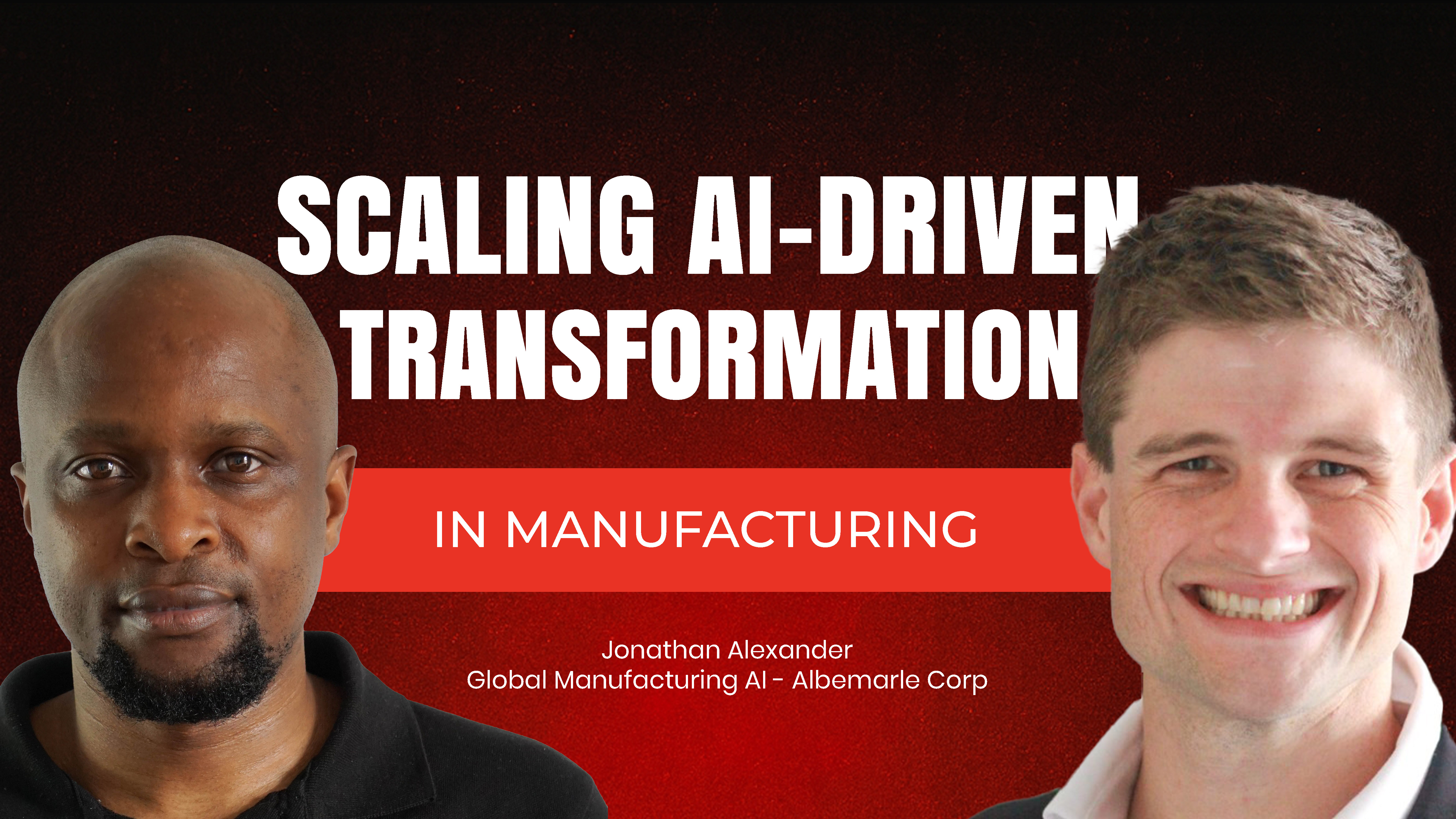November 2, 2025

If your AI pilots keep stalling out after the proof-of-concept phase, you're not alone. You're stuck in what Jonathan Alexander, Global Manufacturing AI and Advanced Analytics Manager at Albemarle Corporation, calls "pilot purgatory, the place where your budgets go to burn and your dreams go to die."
But it doesn't have to be this way. After leading his team from scattered pilots to over $100 million in annual improvements across global manufacturing sites, Alexander has learned what actually works. The answer isn't better algorithms or newer technology. It's about fundamentally rethinking how you approach data, infrastructure, and people.
Stop Chasing Technology, Start Chasing Business Value
Most manufacturing leaders get this backward. They start with the technology and hope business value follows. It rarely does.
Alexander's team made a critical shift early on: they moved from a technology-based vision to what he calls "a relentless focus on business value." This meant getting honest about which initiatives could actually scale and which couldn't.
Here's how they did it:
- Bundled all existing pilots and prototypes across the organization, regardless of who owned them or what technology they used
- Asked one ruthless question about each one: Can we scale this across multiple sites? If the answer was no, they set it aside
- Focused on the 75% of use cases that shared common patterns and could be standardized, rather than trying to solve everything at once
The key insight? You can't scale everything, and trying to will keep you stuck. Pick the battles that matter most and build your foundation there.
Your Data Doesn't Need to Be Perfect - It Needs to Be Contextualized
When most people think about AI readiness, they worry about their instruments and data quality. Should we replace our 50-year-old sensors? Do we need to overhaul our entire data infrastructure?
Alexander's answer might surprise you: probably not.
His team made a strategic decision to leave their source data exactly as it was—even with instruments held together by metaphorical duct tape. Instead, they focused all their energy on the next layer up: data contextualization.
Think of it this way. Your raw sensor data is like having thousands of individual road signs scattered across the country. Contextualization is what turns those signs into Google Maps—organized, interconnected, and actually useful for navigation.
For Albemarle, this meant:
- Building multiple hierarchies for the same equipment (production, maintenance, environmental, quality, SAP functional location) rather than forcing everything into one structure
- Using the PI Asset Framework as their unified namespace to organize manufacturing data semantically, not just chronologically
- Investing 3-6 months upfront at each site just mapping out hierarchies before touching any configuration
This upfront work felt slow. It required patience. But it created a foundation that let them move 10 times faster once they started building.
Build an Analytics Highway, Not Custom Roads
Alexander uses a powerful analogy: the U.S. Interstate Highway System. Before Eisenhower championed its creation in 1955, traveling coast-to-coast took 60+ days on disconnected dirt roads. After? Two days on standardized highways.
The interstate system didn't go everywhere—but it covered 75% of where people needed to go. And every dollar spent on it returned six dollars in economic value.
That's exactly the approach Albemarle took with their analytics infrastructure:
- Created standardized "analytics highways" that solved the majority of use cases the same way at every site globally
- Built one unified lens for viewing process data: Statistical Process Control (SPC) charts for every signal, formatted identically whether you're in Texas, China, or Australia
- Defined two core patterns that covered 98% of scenarios: batch processes and continuous processes, each with its own standardized sampling and analysis approach
- Spent five years implementing the exact same foundation at site after site without deviation
The discipline to not deviate is crucial. Most digital transformations fail because someone changes roles every 2-3 years, starts something new, and nothing ever sticks. Albemarle stayed laser-focused for five years building the same infrastructure repeatedly.
But here's the nuance: they also recognized that standardization can't solve everything. For the remaining 25% of use cases—the exploratory work, the one-off analyses—they're now deploying self-service analytics tools like Seeq that give engineers flexibility without compromising the governed foundation.
Your Biggest Problem Isn't Data - It's People
Here's the hard truth: even with perfect data infrastructure, your AI initiatives will fail if operators and engineers don't use them.
Alexander learned this lesson the expensive way. His team built identical solutions at two sites. The first site used it and saw great ROI. The second site? Nobody touched it.
The technology was the same. The difference? Change management.
When they went back to the struggling site a year later, they didn't change the technology at all. They only focused on the people—spending months working side-by-side with operators and engineers, listening to their needs, integrating the tools into their actual workflow.
The result? Usage skyrocketed and ROI went "off the charts."
Key principles they learned:
- Wildly underestimate change management at your own peril. Budget 6-12 months for organizational change even after the technology is built
- Focus on operators, not just engineers. The future of manufacturing is upskilling frontline workers to act more like engineers, giving them tools to handle issues without escalation
- Build "action boards," not dashboards. Every insight must require action. If operators can't do anything with the information, don't show it to them
- Remove barriers instead of adding features. The goal of technology is to eliminate the time people spend hunting for insights, so they can focus on decisions and actions
Alexander's team even banned the word "dashboard" internally. That one word shift forced everyone to think differently about what they were building and why.
Practical Takeaways for Your Organization
Whether you're just starting or stuck in pilot purgatory, here's how to move forward:
If you're early in your journey:
- Spend 55 minutes planning for every 5 minutes of building (Einstein's problem-solving ratio applies here)
- Map out your business cases 5-10 years into the future before designing any architecture
- Define multiple hierarchies upfront for different stakeholder needs (production, maintenance, quality, etc.)
- Choose which 75% of use cases you'll standardize and accept that 25% will need different approaches
If you're stuck in pilots:
- Audit every pilot against one question: Can this scale? If not, set it aside
- Switch from technology metrics to business value metrics immediately
- Extend your time horizon—think exponentially (3-5 year foundation) not incrementally (quick wins)
- Prepare to invest as much in change management as you do in technology
For everyone:
- Don't wait for perfect data. Work with what you have and focus on contextualization
- Build relationships with IT early for security and data access, even if it slows you down initially
- Create champions on the shop floor by delivering real value to frontline workers first
- Measure success by operator adoption and business outcomes, not number of dashboards built
The Long Game Wins
People overestimate what they can accomplish in three to six months. But they wildly underestimate what they can achieve in three to five years.
That's the ultimate lesson from Albemarle's journey. When everyone else was chasing the next shiny pilot, they spent years building boring infrastructure. When others were focused on proving technology worked, they were focused on proving it could scale.
The result? Over $100 million in annual improvements and a foundation that keeps compounding returns.
Your AI transformation won't happen overnight. But if you focus on business value over technology, build solid infrastructure over quick wins, and invest as heavily in people as you do in platforms, you won't just escape pilot purgatory.
You'll build something that actually scales.
Kudzai Manditereza is an Industry4.0 technology evangelist and creator of Industry40.tv, an independent media and education platform focused on industrial data and AI for smart manufacturing. He specializes in Industrial AI, IIoT, Unified Namespace, Digital Twins, and Industrial DataOps, helping digital manufacturing leaders implement and scale AI initiatives.
Kudzai hosts the AI in Manufacturing podcast and writes the Smart Factory Playbook newsletter, where he shares practical guidance on building the data backbone that makes industrial AI work in real-world manufacturing environments. He currently serves as Senior Industry Solutions Advocate at HiveMQ.



